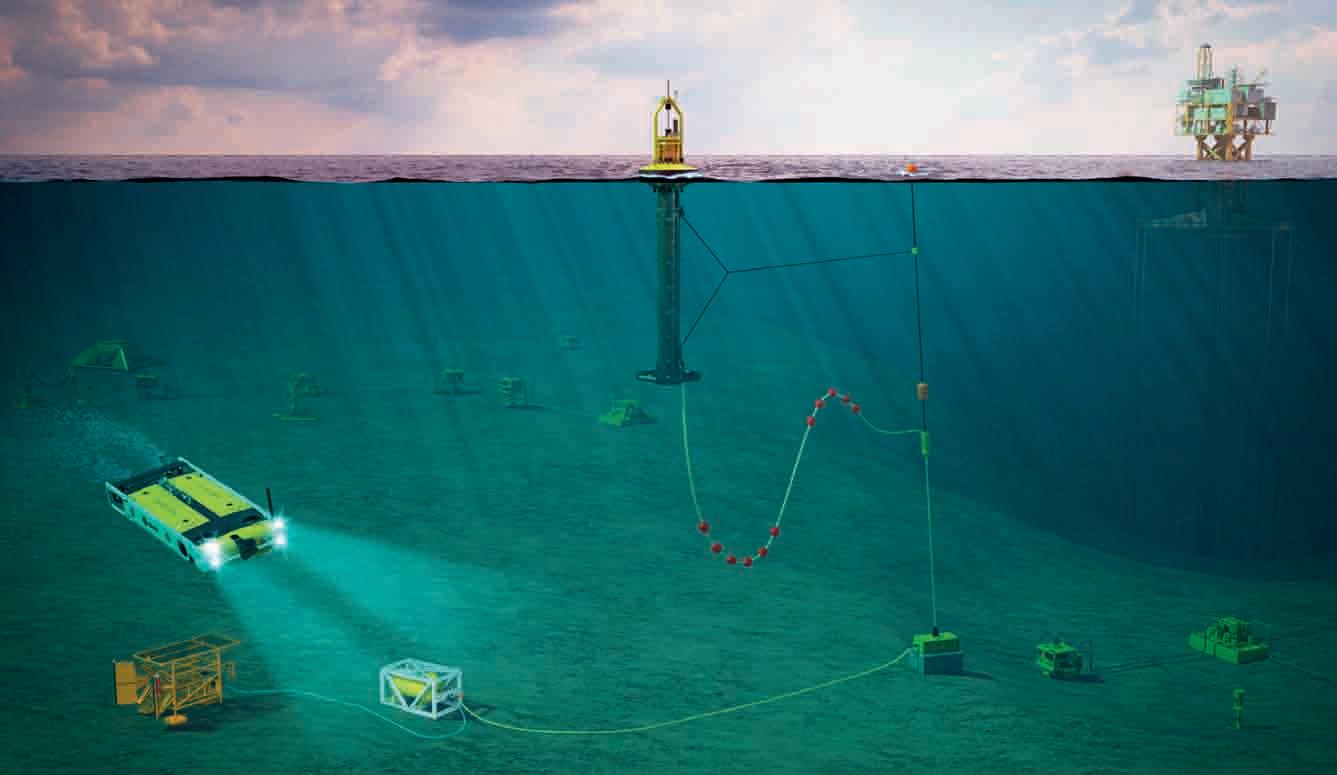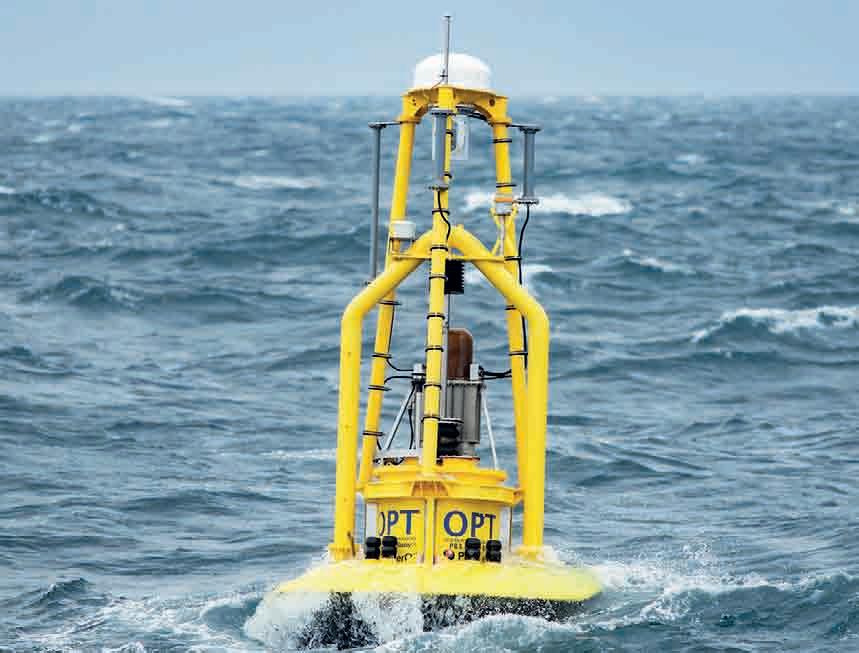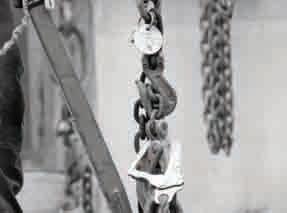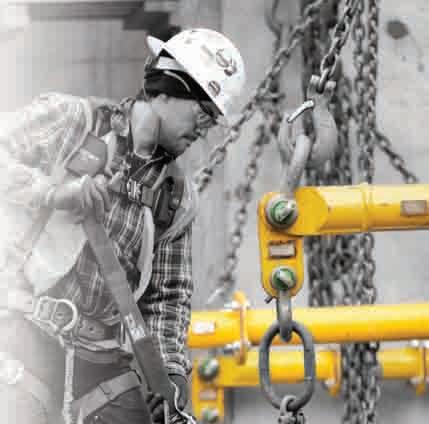
4 minute read
Joining forces for carbon-free autonomous subsea vehicle residency
Ocean Power Technologies’ PB3 PowerBuoy wave energy converter is pictured with innovative single-point mooring integrating power and data transmission connected to a subsea battery solution and autonomous underwater vehicle (AUV) charging station.
OCEAN POWER TECHNOLOGIES (OPT), MODUS SEABED INTERVENTION AND SAAB SEAEYE ARE WORKING TOGETHER ON A GROUND-BREAKING solution for carbon-free subsea autonomous underwater vehicle (AUV) residency. ALL IMAGES COURTESY OF OCEAN POWER TECHNOLOGIES. W e believe a self-contained system powered by an OPT PowerBuoy, and exempt from existing ocean infrastructure has the potential to revolutionise the industrial use of AUVs and make long-term residency a cost-effective reality”, says George Kirby, OPT President and Chief Executive Officer. “Modus Seabed Intervention’s experience with advanced technology development efforts in subsea docking with Saab Seaeye’s hybrid AUV (HAUV) enables autonomous offshore operations and we believe it is a natural fit for our environmentally sound PowerBuoy ocean power and communications technology”, Mr Kirby adds. “We are looking “ forward to working together to further support the growing offshore electrification market.”
Tremendous savings Remote operation without the need for surface vessel support or complex power and data umbilical cable systems to offshore platforms or land has the potential to offer tremendous savings over operations that would otherwise require manned vessels, including long-term environmental monitoring, frequent subsea equipment integrity inspections, and interaction with seafloor assets. This novel system is designed for carbon-free autonomous

offshore operations with the OPT PowerBuoy power and communications platform at its core. Via an innovative integrated mooring and subsea power/data transmission cable, a PowerBuoy can provide carbon-free power to a seabed docking station to recharge an autonomous underwater vehicle while enabling secure data transmission to and from shore-based operations located anywhere in the world. “We are delighted to be collaborating with OPT and Saab to utilise the PB3 PowerBuoy as a localised power and communications source to support low cost and low carbon subsea residency of HAUVs”, voices Jake Tompkins, Chief Executive Officer of Modus. “As a leader in the application of HAUVs and having been involved in developing subsea residency for some time, we are excited to be a part of this innovative program.”
Truly autonomous The ongoing electrification of offshore applications finds underwater vehicles increasingly utilised foredefence and security surveillance, for seafloor mapping and asset maintenance in oil and gas, and for science and research. Increasing the length and the variety of missions an AUV can undertake can drive down costs and risks, and true autonomous control with access to data in real time is a goal for operators. An autonomously powered interactive docking station independent of traditional infrastructure offers efficiency in routine operations and facilitates timely response to ad hoc events (extreme weather, subsea equipment failure) more rapidly than possible with surface-based vessels.
OPT’s PowerBuoy PB3 acts as uninterruptable power supply which constantly recharges itself by harvesting energy from the waves.
It is believed that the OPT/Modus/Saab AUV residency system will boast substantial environmental, risk, safety, and cost benefits over incumbent fossil fuel powered solutions. The system is novel because it is truly autonomous. Removing vessels and umbilical links to fossil fuel generation drops carbon emissions and relocates personnel onshore, cutting risk and costs while increasing safety.
Harvesting energy from the waves Within this project, OPT’s PowerBuoy PB3 acts as uninterruptable power supply which constantly recharges itself by harvesting energy from the waves. It is oceandeployed, moored and floats over the point of use and can operate in any ocean depth over 20m and up to 3,000m. The PB3 supplies power continuously to on-board payloads or equipment located on the seabed while also providing real-time data transfer and communication to remote shore facilities. The PB3 is sized and designed to store sufficient electric energy to provide reliable ‘ride through’ power in extended periods of flat-calm seas. The conversion of wave energy into electric power is carried out through a direct-drive generator that continuously charges an on-board battery pack. Power from the battery is delivered to meet application and end-user needs. This is particularly advantageous for applications that have varying power requirements including continuous and larger occasional peaks. OPT has designed the PB3 to minimise operational costs (OPEX) whereby deployment and recovery thereof is simplified, leveraging vessels widely employed in offshore marine operations. The PB3 can be either towed to site or deployed from a vessel’s deck.
i. oceanpowertechnologies.com
The Original and the Best

Efficient MODULAR design Adaptable | Compatible | Portable
Technical Experts A team of in-house engineers and specialists, with over 200 years combined experience
New State of the Art Factory Faster turnaround times, increased storage space and all of your technical experts under one roof
Global Distribution Network To find your nearest visit Modulift.com

Innovating the lifting industry



For more information contact 00 44 1202 233 844 sales@modulift.com www.modulift.com
PROJECT AND MOBILIZATION SUPPORT DIRECTLY FROM OUR NEW LOCATION NOW AT MERWEHAVEN 32E/F











